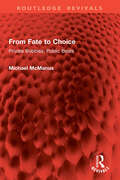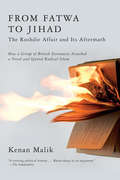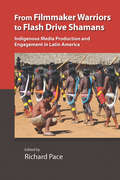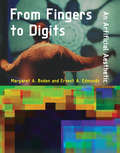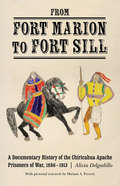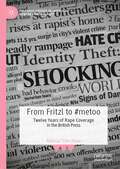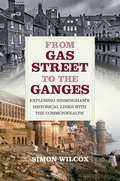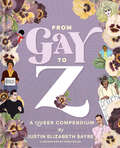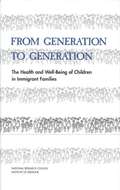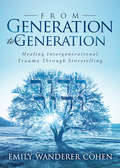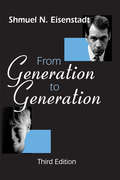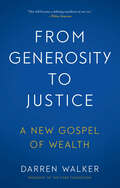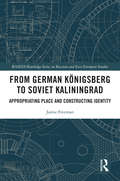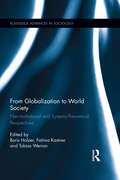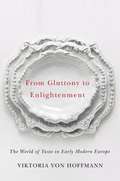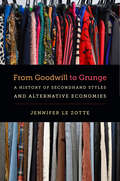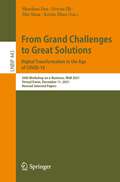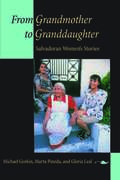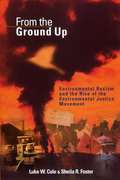- Table View
- List View
From Fate to Choice: Private Bobbies, Public Beats (Routledge Revivals)
by Michael McManusIn the 1990s private security patrols in public places were occurring in many areas of the UK and moving closer to that traditional domain of the public police – streets and neighbourhoods. Such a phenomenon was ripe for sociological enquiry and, accordingly, this book, originally published in 1995, provides a focused interpretation of six key concepts, each central to the equity debate on private policing. Data from three research sites in the UK are presented throughout the book in the form of case studies. Equity of justice is crucial and intrinsic to the association policing should have with a democratic, equal and free society. Private security, however, is not conducive to these requirements for it has an inherently competitive style excluding freedom from those who are non-competitive through either choice of economic disadvantage. Accordingly, an embarrassing characteristic of private security policing is that it promises too much freedom of choice in a less than equal world
From Fatwa to Jihad
by Kenan MalikThe # 1 international bestseller A Finalist for the George Orwell Book Prize"It would be absurd to think that a book can cause riots," Salman Rushdie asserted just months before the publication of his novel The Satanic Verses. But that's exactly what eventually happened. In England, protests started just months after the book's publication, with Muslim protestors, mainly from immigrant backgrounds, coming by the thousands from the outer suburbs of London and from England's old industrial centers--places like Bradford, Bolton, and Macclesfield--to denounce Rushdie's novel as blasphemous and to burn it. In February of 1988, the protests spread to Pakistan, where riots broke out, killing five. That same month, Iran's Ayatollah Khomeini called for Rushdie's assassination, and for the killing of anyone involved with the book's publication. It was this frightening chain of events, Kenan Malik argues in his enlightened personal and political account of the period, that transformed the relationship between Islam and the West: From then on, Islam was a domestic issue for residents of Europe and the United States, a matter of terror and geopolitics that was no longer geographically constrained to the Middle East and South Asia. Malik investigates the communities from which the anti-Rushdie activists emerged, showing the subtleties of immigrant life in 1980s England. He depicts the growth of the anti-racist and Asian youth movements, and shows how young Britons went from supporting these progressive movements to embracing a conservative strain of Islam. Malik also controversially tackles England's peculiar strain of "multiculturalism," arguing that policymakers there failed to integrate Muslim immigrants, which many politicians saw as incompatible with their own "Western values." It was a perception that led many to appeal to Muslims not as citizens, but as people whose primary loyalty was to their faith and who could be engaged only by their "community leaders." It was a also policy that encouraged Muslims to view themselves as semi-detached citizens--and that inevitably played into the hands of radical Islamists. Twenty years later, the questions raised by the Rushdie affair--Islam's relationship to the West, the meaning of multiculturalism, the limits of tolerance in a liberal society--have become the defining issues of our time.
From Female to Male: The Life of Jack Bee Garland
by Louis SullivanA mysterious person who dressed in men's clothes came to Stockton, CA and lived on an "ark" (houseboat). It was deemed that Babe Bean, although female, was not breaking any laws by cross-dressing, as he was not attempting any criminal activity. Many newspaper articles written by Bean provide the information of this book. Bean/Garland never enjoyed the company of women or wanted to be one. He wrote that he completely enjoyed male company and male pastimes. Later Bean moved onto San Francisco and continued writing newspaper articles. As a male, Jack Bean was present in Manila during the Spanish American War. Later in San Francisco, the earthquake and resulting fires brought Bean into rescue nursing, a skill learned in the war. Then cross-dressing was outlawed altogether. Bean changed his name to Jack Bee Garland and was known as a male until his death. At that time, his background became publicly known. Bibliography of sources is given at the end of the book.
From Fetish To God Ancient Egypt
by E.A. Wallis BudgeFirst published in 2005. Written by eminent Egyptologist, E.A. Wallis Budge, this work addresses Egyptian religion and mythology in all of its manifestations, from times when earth, sea air and shy were filled with hostile spirits and men lived in terror of the Evil Eye, to the moment when Egyptians hailed Amen-Ra as their one god. Topics include the predynastic cults, magic, gods (cosmic, stellar, borrowed and foreign), Memphite theology, judgement of the dead, and the underworld. Important hymns and legends, in English translation are included.
From Filmmaker Warriors to Flash Drive Shamans: Indigenous Media Production and Engagement in Latin America (Vanderbilt Center for Latin American Studies Series)
by Richard PaceFrom Filmmaker Warriors to Flash Drive Shamans broadens the base of research on Indigenous media in Latin America through thirteen chapters that explore groups such as the Kayapó of Brazil, the Mapuche of Chile, the Kichwa of Ecuador, and the Ayuuk of Mexico, among others, as they engage video, DVDs, photography, television, radio, and the internet.The authors cover a range of topics such as the prospects of collaborative film production, the complications of archiving materials, and the contrasting meanings of and even conflict over "embedded aesthetics" in media production—i.e., how media reflects in some fashion the ownership, authorship, and/or cultural sensibilities of its community of origin. Other topics include active audiences engaging television programming in unanticipated ways, philosophical ruminations about the voices of the dead captured on digital recorders, the innovative uses of digital platforms on the internet to connect across generations and even across cultures, and the overall challenges to obtaining media sovereignty in all manner of media production.The book opens with contributions from the founders of Indigenous Media Studies, with an overview of global Indigenous media by Faye Ginsburg and an interview with Terence Turner that took place shortly before his death.
From Filmmaker Warriors to Flash Drive Shamans: Indigenous Media Production and Engagement in Latin America (Vanderbilt Center for Latin American Studies Series)
by Richard PaceFrom Filmmaker Warriors to Flash Drive Shamans broadens the base of research on Indigenous media in Latin America through thirteen chapters that explore groups such as the Kayapó of Brazil, the Mapuche of Chile, the Kichwa of Ecuador, and the Ayuuk of Mexico, among others, as they engage video, DVDs, photography, television, radio, and the internet. The authors cover a range of topics such as the prospects of collaborative film production, the complications of archiving materials, and the contrasting meanings of and even conflict over "embedded aesthetics" in media production—i.e., how media reflects in some fashion the ownership, authorship, and/or cultural sensibilities of its community of origin. Other topics include active audiences engaging television programming in unanticipated ways, philosophical ruminations about the voices of the dead captured on digital recorders, the innovative uses of digital platforms on the internet to connect across generations and even across cultures, and the overall challenges to obtaining media sovereignty in all manner of media production. The book opens with contributions from the founders of Indigenous Media Studies, with an overview of global Indigenous media by Faye Ginsburg and an interview with Terence Turner that took place shortly before his death.
From Fingers to Digits: An Artificial Aesthetic (Leonardo)
by Margaret A. Boden Ernest A. EdmondsEssays on computer art and its relation to more traditional art, by a pioneering practitioner and a philosopher of artificial intelligence.In From Fingers to Digits, a practicing artist and a philosopher examine computer art and how it has been both accepted and rejected by the mainstream art world. In a series of essays, Margaret Boden, a philosopher and expert in artificial intelligence, and Ernest Edmonds, a pioneering and internationally recognized computer artist, grapple with key questions about the aesthetics of computer art. Other modern technologies—photography and film—have been accepted by critics as ways of doing art. Does the use of computers compromise computer art's aesthetic credentials in ways that the use of cameras does not? Is writing a computer program equivalent to painting with a brush?Essays by Boden identify types of computer art, describe the study of creativity in AI, and explore links between computer art and traditional views in philosophical aesthetics. Essays by Edmonds offer a practitioner's perspective, considering, among other things, how the experience of creating computer art compares to that of traditional art making. Finally, the book presents interviews in which contemporary computer artists offer a wide range of comments on the issues raised in Boden's and Edmonds's essays.
From Fort Marion to Fort Sill: A Documentary History of the Chiricahua Apache Prisoners of War, 1886-1913
by Alicia DelgadilloFrom 1886 to 1913, hundreds of Chiricahua Apache men, women, and children lived and died as prisoners of war in Florida, Alabama, and Oklahoma. Their names, faces, and lives have long been forgotten by history, and for nearly one hundred years these individuals have been nothing more than statistics in the history of the United States&’ tumultuous war against the Chiricahua Apache.Based on extensive archival research, From Fort Marion to Fort Sill offers long-overdue documentation of the lives and fate of many of these people. This outstanding reference work provides individual biographies for hundreds of the Chiricahua Apache prisoners of war, including those originally classified as POWs in 1886, infants who lived only a few days, children removed from families and sent to Indian boarding schools, and second-generation POWs who lived well into the twenty-first century. Their biographies are often poignant and revealing, and more than 60 previously unpublished photographs give a further glimpse of their humanity.This masterful documentary work, based on the unpublished research notes of former Fort Sill historian Gillett Griswold, at last brings to light the lives and experiences of hundreds of Chiricahua Apaches whose story has gone untold for too long.
From Fossil Fuels to Low Carbon Energy Transition: New Regulatory Trends in Latin America (Energy, Climate and the Environment)
by Geoffrey Wood Juan Felipe Neira-CastroFocusing on five key themes - hydrocarbons, electricity, mining, social license to operate, and arbitration/dispute resolution- via in-depth country and regional case studies, this book seeks to capture the contrasting and sometimes conflicting trends in energy governance in Latin America as it wrestles with a dependence on fossil fuels whilst shifting toward a low carbon future. Energy transition continues to sit at the centre of the Latin American policy debate as the world continues to push for carbon neutrality by 2050. Latin America is undergoing a renewable energy transition, with substantial reserves (solar, wind, hydro, geothermal) and many countries in the region setting ambitious renewable energy policies, laws, and regulations to address climate change. However, recent initiatives to promote renewables must be placed in context. Historically, Latin America has developed and improved its economic and social standards due primarily to an economy based on the extractive industries and fossil fuels. This places renewables at the crossroads of multiple drivers, as the region seek to ensure security of supply, attract investment, and facilitate a low carbon energy transition.
From Fritzl to #metoo: Twelve Years of Rape Coverage in the British Press (Palgrave Studies in Language, Gender and Sexuality)
by Alessia TrancheseThis is the first longitudinal study of the language used by the British press to talk about rape. Through a diachronic analysis informed by corpus linguistics and feminist theory, Tranchese examines how rape discourse has (or has not) changed over the past decade. With its detailed investigation of media representations, the book explores how age-old myths about sexual violence re-emerge in different forms within news narratives. Against the backdrop of twelve years of newspaper coverage of rape, including many high-profile cases, this study also traces the rise of “celebrity culture”, the emergence of #metoo, and the development of the backlash against it. The author places these historical events and recent trends within broader debates on feminism and the role played by (social) media in shaping contemporary rape discourse. This book provides a much-needed linguistic analysis which will be of particular interest to scholars and students of feminist studies, language and gender, corpus-assisted discourse studies, and gendered crime.
From Gas Street to the Ganges: Exploring Birmingham’s Historical Links with the Commonwealth
by Simon WilcoxIf ever there was a regional UK city with the credentials to host the 2022 Commonwealth Games, Birmingham was always it. One in ten people in the city were born in an overseas Commonwealth country, and even more have family in member nations such as India, Jamaica and Pakistan. Many of these are descendants of the generation who arrived after the Second World War to find work during the city’s manufacturing boom years.But, as Simon Wilcox discovers, the links go much further back than that. In fact, the connections started with the canal-building zeal of Birmingham’s industrial pioneers in the eighteenth century who built a canal network that spanned out from the Gas Street Basin. It was this network that opened up a new world of trade for the city – a world which revolved around metal, chocolate and weekly shipments of Ceylon tea.Industry and craftmanship, music and food, nostalgia and the future: From Gas Street to the Ganges is an exploration and celebration of the city of a thousand trades, which became the city of Balti and Bhangra.
From Gay to Z: A Queer Compendium
by Justin Elizabeth SayreThis illustrated compendium celebrates LGBTQIA+ history and culture, written by and according to culture icon Justin Elizabeth Sayre!Based on Sayre's five-part show in New York City, From Gay to Z is a humorous collection of the rich legacy of gay culture, told through the letters of the alphabet. From ABBA to addiction, hair and makeup to HIV, Fannie Flagg to fierce, Sayre offers their own perspective on the things that have influenced gay culture today, including iconic figures, historical moments, ongoing issues in the LGBTQIA+ community, and everything in between. As gay culture is always evolving and different for everyone, this book does not serve as a definitive guide—instead, Sayre encourages readers to use this knowledge to reflect on the things that have informed their personal identities. Engagingly written and beautifully designed, From Gay to Z is a distinctive and dynamic look at gay culture for LGBTQIA+ readers everywhere.STRONG VOICE AND ENGAGING CONTENT: Sayre's writing is lively, engaging, and rich. The entries have their own style and contain humorous anecdotes, facts, commentary, and more—all told through Sayre's animated yet authoritative voice.BELOVED, WELL-KNOWN AUTHOR: Sayre is active and well-known in the LGBTQIA+ community and beyond. They've been recognized as one of "LA's 16 Most Talented LGBT Comics" by Frontiers Magazine, and their debut comedy album, The Gay Agenda, was named one of 2016's "Best Things in Comedy" by The Comedy Bureau. They host their own podcast, Sparkle & Circulate, where they interview performers, writers, and other creative minds of the LGBTQIA+ community. As an activist, Justin's charity benefit show, "Night of a Thousand Judys," raises money for the Ali Forney Center for Homeless LGBTQIA+ youth and is now in its 7th year.Perfect for:• LGBTQIA+ people of all ages• Fans of Trixie and Katya's Guide to Modern Womanhood• Those looking for a birthday or holiday gift for their LGBTQIA+ friends and family
From GDP to Sustainable Wellbeing: Changing Statistics or Changing Lives? (Wellbeing in Politics and Policy)
by Paul Allin David J. HandThis book is about the function and use of official statistics. It welcomes the aspiration for official statistics to be an indispensable element in the information system of a democratic society, serving the government, the economy and the public with data about the economic, demographic, social and environmental situation. The book identifies the political role of official statisticians, who decided what gets measured as well as how it is measured. While thousands of official statistics are published every year, and some are quoted by politicians, used by policy-makers or reported in the media, the authors observe that, in the main, official statistics do not feature much in everyday lives of people and businesses. The book concludes with suggestions for more that should be done, especially in the context of improving wellbeing and helping meet the worldwide set of sustainable development goals set for 2030.
From Generation to Generation: The Health and Well-Being of Children in Immigrant Families
by Adjustment of Immigrant Families Committee on the HealthImmigrant children and youth are the fastest growing segment of the U.S. population, and so their prospects bear heavily on the well-being of the country. However, relevant public policy is shaped less by informed discussion than by politicized contention over welfare reform and immigration limits.From Generation to Generation explores what we know about the development of white, black, Hispanic, and Asian children and youth from numerous countries of origin. Describing the status of immigrant children and youth as "severely understudied," the committee both draws on and supplements existing research to characterize the current status and outlook of immigrant children.The book discusses the many factors--family size, fluency in English, parent employment, acculturation, delivery of health and social services, and public policies--that shape the outlook for the lives of these children and youth. The committee makes recommendations for improved research and data collection designed to advance knowledge about these children and, as a result, their visibility in current policy debates.
From Generation to Generation: Healing Intergenerational Trauma Through Storytelling
by Emily Wanderer CohenMost children and grandchildren of Holocaust survivors felt the omnipresence of the Holocaust throughout their childhood and for many, the spectre of the Holocaust continues to loom large through the phenomenon of &“intergenerational&” or &“transgenerational&” trauma. In From Generation to Generation: Healing Intergenerational Trauma Through Storytelling, Emily Wanderer Cohen connects the dots between her behaviors and choices and her mother&’s Holocaust ex-periences. In a series of vivid, emotional—and sometimes gut-wrenching—stories, she illustrates how the Holocaust continues to have an impact on current and future generations. Plus, the prompts at the end of each chapter enable you to explore your own intergenerational trauma and begin your healing journey.Part memoir and part self-discovery, if you&’re a second-generation (2G) or third-generation (3G) Holo-caust survivor—or you&’re experiencing intergenerational trauma of any kind—and you&’re ready to heal from that trauma, you need to read this book.
From Generation to Generation
by Shmuel N. EisenstadtThe republication of From Generation to Generation-almost half a century after its first appearance in 1956-constitutes a good occasion for a look at the way in which problems of youth and generations developed in contemporary societies. In this brilliant, pioneering effort, different approaches in the social sciences to the analysis of these issues receive close scrutiny. Eisenstadt reexamines these issues by including in this edition several new chapters on this theme.
From Generosity to Justice: A New Gospel of Wealth
by Darren WalkerAndrew Carnegie wrote his original "Gospel of Wealth" in 1889, during the height of the gilded age, when the country's 4,000 richest families held almost as much wealth as the other 11.6 million American families combined. His essay laid the foundation for modern philanthropy. Today, we find ourselves in a new gilded age—defined by levels of inequality that far surpass those of Carnegie's time. The widening chasm between haves and have-nots demands our immediate attention. Now is the time for a new "Gospel of Wealth." In From Generosity to Justice: A New Gospel of Wealth, Darren Walker, president of the Ford Foundation, articulates a bold vision for philanthropy in the twenty-first century. With contributions from an array of thinkers, activists, and leaders including Ai-jen Poo, Laurene Powell Jobs, David Rockefeller Jr., and Dr. Elizabeth Alexander, Walker challenges and emboldens readers to consider philanthropy as a tool for achieving economic, social, and political justice. That task requires humility, moral courage, and an unwavering commitment to democratic values and institutions. It demands that all members of society recognize their own privilege and position, address the root causes of social ills, and seek out and listen to those who live amid and experience injustice. What began in Carnegie's day as a manual for generosity now becomes a guide that moves us closer to justice—a guide that helps each of us find a way to contribute. Justice is calling. It's time we answer.
From German Königsberg to Soviet Kaliningrad: Appropriating Place and Constructing Identity (BASEES/Routledge Series on Russian and East European Studies)
by Jamie FreemanThis book explores how the Soviet Union, after capturing and annexing the German East Prussian city of Königsberg in 1945 and renaming it Kaliningrad, worked to transform the city into a model of Soviet modernity. It examines how the Soviets expelled all the remaining German people, repopulated the city and region with settlers from elsewhere in the Soviet Union, destroyed the key remaining German buildings and began building a model Soviet city, a physical manifestation of the societal transformation brought about by communism. However, the book goes on to show that over time many of the model Soviet buildings were uncompleted and that the citizens, aware of their Polish and Lithuanian neighbours to both the east and the west and appreciating their place in the wider Baltic region, came to view themselves as something different from other Soviet and Russian citizens. The book concludes by assessing present developments as the people of Kaliningrad are increasingly rediscovering the city’s pre-Soviet past and forging a new identity for themselves on their own terms.
From Globalization to World Society: Neo-Institutional and Systems-Theoretical Perspectives (Routledge Advances in Sociology)
by Boris Holzer Fatima Kastner Tobias WerronSince the 1970s, various sociological approaches have tried to understand and conceptualize "the global," yet few of them have systematically addressed the full spectrum of social relationships. Prominent exponents of the global approach - such as world systems analysis - instead have focused on particular domains such as politics or the economy. Under the label of "world society," however, some authors have suggested alternatives to the predominant equivocation of society and the nation-state. The contributions to this volume share that objective and take their point of departure from the two most ambitious projects of a theory of world society: world polity research and systems theory, mapping out the common ground and assessing their potential to inform empirical analyses of globalization.
From Gluttony to Enlightenment: The World of Taste in Early Modern Europe
by Viktoria Von HoffmannScorned since antiquity as low and animal, the sense of taste is celebrated today as an ally of joy, a source of adventure, and an arena for pursuing sophistication. The French exalted taste as an entrée to ecstasy, and revolutionized their cuisine and language to express this new way of engaging with the world. Viktoria von Hoffmann explores four kinds of early modern texts--culinary, medical, religious, and philosophical--to follow taste's ascent from the sinful to the beautiful. Combining food studies and sensory history, she takes readers on an odyssey that redefined a fundamental human experience. Scholars and cooks rediscovered a vast array of ways to prepare and present foods. Far-sailing fleets returned to Europe bursting with new vegetables, exotic fruits, and pungent spices. Hosts refined notions of hospitality in the home while philosophers pondered the body and its perceptions. As von Hoffmann shows, these labors produced a sea change in perception and thought, one that moved taste from the base realm of the tongue to the ethereal heights of aesthetics.
From Goodwill to Grunge: A History of Secondhand Styles and Alternative Economies (Studies in United States Culture)
by Jennifer Le ZotteIn this surprising new look at how clothing, style, and commerce came together to change American culture, Jennifer Le Zotte examines how secondhand goods sold at thrift stores, flea markets, and garage sales came to be both profitable and culturally influential. Initially, selling used goods in the United States was seen as a questionable enterprise focused largely on the poor. But as the twentieth century progressed, multimillion-dollar businesses like Goodwill Industries developed, catering not only to the needy but increasingly to well-off customers looking to make a statement. Le Zotte traces the origins and meanings of "secondhand style" and explores how buying pre-owned goods went from a signifier of poverty to a declaration of rebellion.Considering buyers and sellers from across the political and economic spectrum, Le Zotte shows how conservative and progressive social activists--from religious and business leaders to anti-Vietnam protesters and drag queens--shrewdly used the exchange of secondhand goods for economic and political ends. At the same time, artists and performers, from Marcel Duchamp and Fanny Brice to Janis Joplin and Kurt Cobain, all helped make secondhand style a visual marker for youth in revolt.
From Grammar to Politics: Linguistic Anthropology in a Western Samoan Village
by Alessandro DurantiAlessandro Duranti explores the way traditional oratory in a Samoan village is shaped by the needs of the political process and shows how language insulates ceremonial speakers from the perils of everyday confrontation. He proposes a "moral flow hypothesis" in discourse, to describe a grammar that distributes praise and blame and in that way defines the standing of individuals in the community. <p><p>This ethnographic journey from linguistic to political anthropology demonstrates that the analysis of grammar in context needs ethnography just as much as the conduct of politics needs grammatical analysis.
From Grand Challenges to Great Solutions: 20th Workshop on e-Business, WeB 2021, Virtual Event, December 11, 2021, Revised Selected Papers (Lecture Notes in Business Information Processing #443)
by Shaokun Fan Noyan Ilk Zhe Shan Kexin ZhaoThis book constitutes revised selected papers from the 20th Workshop on e-Business, WeB 2021, which took place virtually on December 11, 2021.The purpose of WeB is to provide a forum for researchers and practitioners to discuss findings, novel ideas, and lessons learned to address major challenges and map out the future directions for e-Business. The WeB 2021 theme was “From Grand Challenges to Great Solutions: Digital Transformation in the Age of COVID-19.” The 8 papers included in this volume were carefully reviewed and selected from a total of 24 submissions. The contributions are organized in topical sections as follows: digital innovation and transformation, and e-commerce and social media.
From Grandmother to Granddaughter
by Michael Gorkin Marta Pineda Gloria LealThe life histories and testimonies of nine Salvadoran women from different generations shape this intimate portrayal of contemporary El Salvador. The authors interviewed a grandmother, mother, and granddaughter from three Salvadoran families: La Familia Nuñez, members of the upper class; La Familia Rivas, from El Salvador's growing middle class; and La Familia García, from the campo, the Salvadoran peasantry. The voices we hear convey a deep sense of the world of Salvadoran women and how life is lived in that Central American country today. Each woman tells her own life story, and interspersed with recollections of childhood, marriage, and childrearing are revealing accounts of El Salvador's turbulent political past and present. Reflected in the stories are the vast changes in educational and occupational opportunities for women and the shifts in male-female relationships. Class differences are still a fundamental part of Salvadoran life, but changes are occurring in this area as well. From Grandmother to Granddaughter is a vivid and authentic portrait of today's El Salvador that convincingly illustrates how individual lives can reflect the larger changes within a society.
From The Ground Up: Environmental Racism and the Rise of the Environmental Justice Movement
by Luke W. Cole Sheila R. FosterWhen Bill Clinton signed an Executive Order on Environmental Justice in 1994, the phenomenon of environmental racism--the disproportionate impact of environmental hazards, particularly toxic waste dumps and polluting factories, on people of color and low-income communities--gained unprecedented recognition. Behind the President's signature, however, lies a remarkable tale of grassroots activism and political mobilization. Today, thousands of activists in hundreds of locales are fighting for their children, their communities, their quality of life, and their health. From the Ground Up critically examines one of the fastest growing social movements in the United States, the movement for environmental justice. Tracing the movement's roots, Luke Cole and Sheila Foster combine long-time activism with powerful storytelling to provide gripping case studies of communities across the U. S--towns like Kettleman City, California; Chester, Pennsylvania; and Dilkon, Arizona--and their struggles against corporate polluters. The authors effectively use social, economic and legal analysis to illustrate the historical and contemporary causes for environmental racism. Environmental justice struggles, they demonstrate, transform individuals, communities, institutions and even the nation as a whole.
